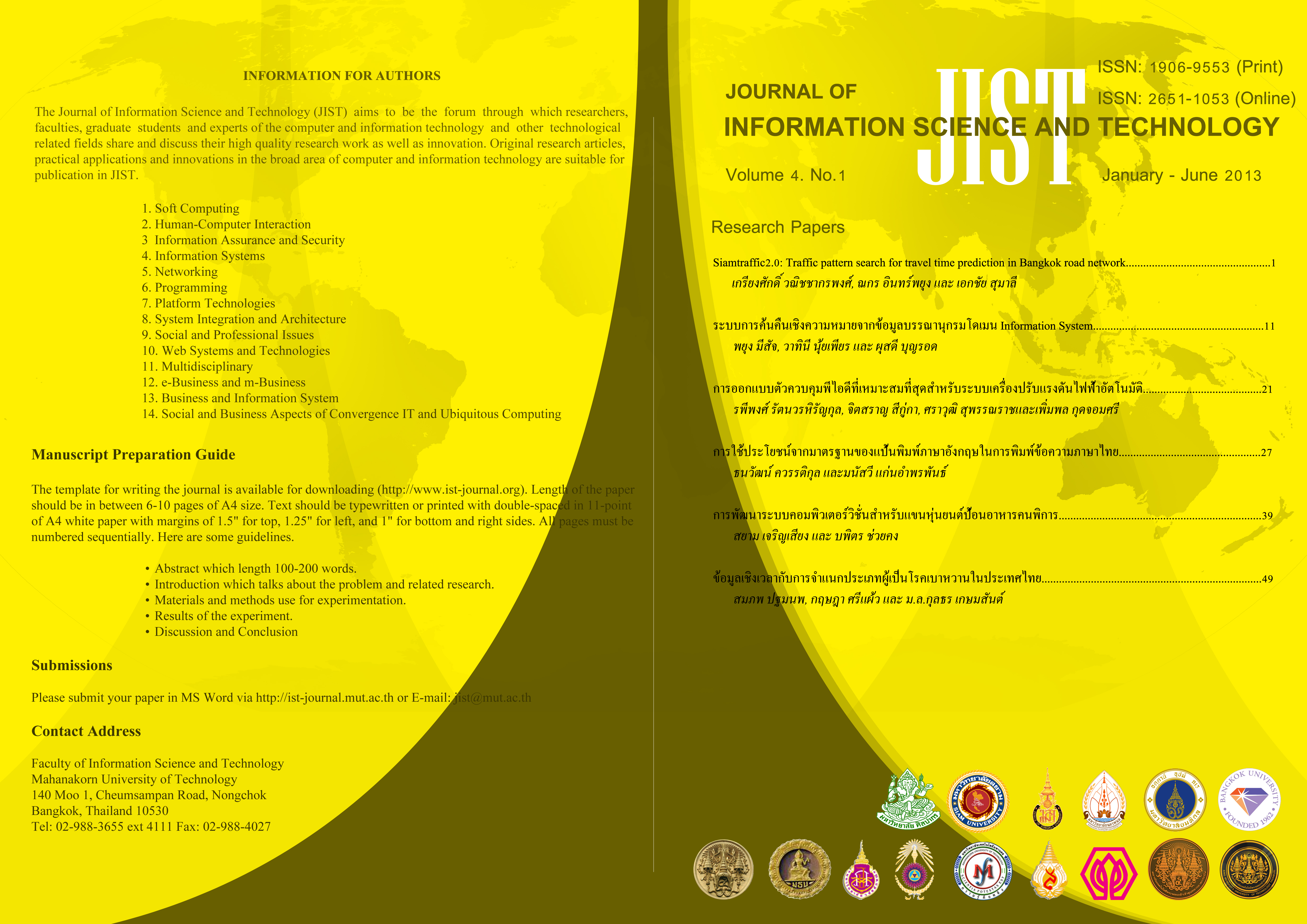Development of Computer Vision System for Food Feeding Robot Arm for the Disabled Person
Main Article Content
Abstract
- This research presents the development of computer vision to determine the locations of a spoon, a food plate, and a water glass along with the orientation of a spoon on the tray. The tracked information will be sent to a robot arm to feed food to the disabled person. The SIFT feature technique is applied to find the recognized objects. It can take care of lighting and image’s rotation with noises. The proposed system can find the spoon within 1.7 seconds with accuracy of tracked location with less than +14 mm. In addition, the computer vision can send all tracked information to the robot arm in order to pick up the targeted object automatically.
Article Details
This work is licensed under a Creative Commons Attribution-NonCommercial-NoDerivatives 4.0 International License.
I/we certify that I/we have participated sufficiently in the intellectual content, conception and design of this work or the analysis and interpretation of the data (when applicable), as well as the writing of the manuscript, to take public responsibility for it and have agreed to have my/our name listed as a contributor. I/we believe the manuscript represents valid work. Neither this manuscript nor one with substantially similar content under my/our authorship has been published or is being considered for publication elsewhere, except as described in the covering letter. I/we certify that all the data collected during the study is presented in this manuscript and no data from the study has been or will be published separately. I/we attest that, if requested by the editors, I/we will provide the data/information or will cooperate fully in obtaining and providing the data/information on which the manuscript is based, for examination by the editors or their assignees. Financial interests, direct or indirect, that exist or may be perceived to exist for individual contributors in connection with the content of this paper have been disclosed in the cover letter. Sources of outside support of the project are named in the cover letter.
I/We hereby transfer(s), assign(s), or otherwise convey(s) all copyright ownership, including any and all rights incidental thereto, exclusively to the Journal, in the event that such work is published by the Journal. The Journal shall own the work, including 1) copyright; 2) the right to grant permission to republish the article in whole or in part, with or without fee; 3) the right to produce preprints or reprints and translate into languages other than English for sale or free distribution; and 4) the right to republish the work in a collection of articles in any other mechanical or electronic format.
We give the rights to the corresponding author to make necessary changes as per the request of the journal, do the rest of the correspondence on our behalf and he/she will act as the guarantor for the manuscript on our behalf.
All persons who have made substantial contributions to the work reported in the manuscript, but who are not contributors, are named in the Acknowledgment and have given me/us their written permission to be named. If I/we do not include an Acknowledgment that means I/we have not received substantial contributions from non-contributors and no contributor has been omitted.
References
2. Shahram Jafari and Ray Jarvis, "Eye-To-Hand Coordination: A Coarse-Calibrated Approach," presented at The 2004 Australasian Conference on Robotics and Automation (ACRA), Canberra, Australia, Dec. 2004.
3. Andrew Dankers, Nick Barnes, and Alex Zelinsky, “Primate Structures in Synthetic Dynamic Active Visual Saliency,” 6th International Conference on Epigenetic Robotics (Epirob 2006): Modeling Cognitive Development in Robotic Systems. Paris, France, 2006.
4. Ioannis Iossifidis, Carsten Bruckhoff, Christoph Theis, Claudia Grote, Christian Faubel and Gregor Schöner, “CORA: An anthropomorphic robot assistant for human environment,” In Robot and Human Interactive Communication, 2002. Proceedings. 11th IEEE International Workshop, Berlin, Germany, Sep. 2002, pp. 392-398.
5. David G. Lowe, “Object Recognition from Local Scale-invariant Feature”, International Conference on Computer Vision, Corfu, Greece, Sep.1999, pp. 1-10.
6. David G. Lowe, “Distinctive Image Features from Scale-invariant Key-point”, International Journal of Computer Vision, vol. 60, pp. 91-110, January 2004.
7. Gary Bradski and Adrian Kaebler, Learning OpenCV: Computer Vision with the OpenCV Library. O'Reilly Media, Inc., 2008.



